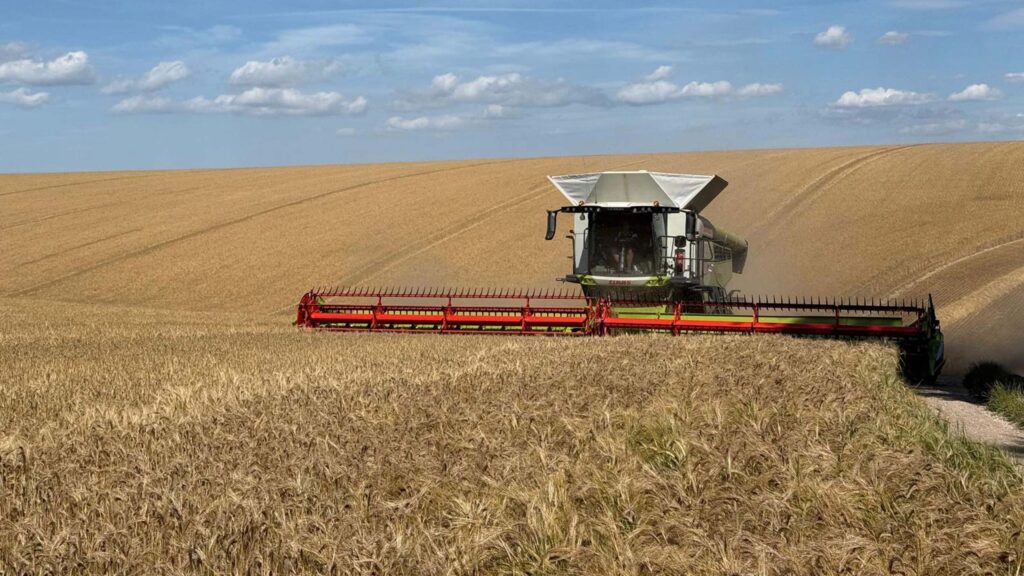Harvest 2025: Winter barley yields well in Northern Ireland
 © Josh Stratton
© Josh Stratton Despite the showers, combines are still rolling across the country, with winter barley showing strong quality but variable yields.
Oilseed rape and wheat yields are more mixed, although the dry grain and early harvest offer some positives.
See also: Grassweed control – sequencing and timing key in warmer winters
Perthshire
Adrian Ivory began combining yesterday (July 23) on his Perthshire farm and has already cut 40ha of Caravelle winter barley, yielding an impressive 9.4t/ha, up significantly from last year’s 8t/ha.
“These were two good fields,” he says. “The rest will likely pull the average down slightly, but I still expect to beat last year.”
Specific weights have been around 69kg/hl, and moisture levels are averaging 16.5-17%. The overall quality is holding well.
Looking ahead, the Sassy and Fairing spring barley are expected to be ready by the first week of August, about two weeks ahead of last year.
However, Adrian is cautious about the barley nitrogen levels, due to this season’s dry spell followed by rain.
“There’s concern that nitrogen uptake has been delayed, which could push levels too high.” Complicating matters is significant second growth, triggered by late rain.
“You either have to be patient and wait for it all to ripen, or manage it carefully with Roundup – we will do both,” he explains.
County Londonderry
Over the water in Londonderry, favourable weather has helped deliver Richard Kane one of his best winter barley crops in recent years at Broglasgow House.
“We’ve taken off 40ha of Tardis winter barley so far, averaging 6.18t/ha, with another 32ha to go,” he says. “It’s definitely better than normal and the best we’ve had in about four years.”
A good autumn and an easy spring helped set the crop up well, and straw quality has also been strong. “Straw prices are helping compensate for any yield dips elsewhere, though this has been a decent year overall,” he adds.
Winter wheat is about three weeks off and is looking promising, and while the spring oilseed rape is still six weeks away, it is showing real potential. “It’s a nice change from the past few seasons,” Richard says.
Wiltshire
It’s a similar story at East Farm near Codford St Mary, where harvest is well under way for Josh Stratton. He has completed 195ha of Craft winter barley, which yielded an impressive 9t/ha.
“It’s all malting spec and has come in really well,” he says. “It looked good all year; some fields were exceptional, others more average, but we’re happy with the result.”
His 92ha of Maple peas, drilled in late March, also exceeded expectations. “They struggled to get going, but they’ve yielded well at 4.4t/ha.”

© Josh Stratton
Oilseed rape was more variable, with a wide range of results across 175ha following an autumn sheep grazing trial.
“Where we grazed late, yields were around 3-3.5t/ha, but where we grazed early or not at all, performance was much better. We ended up averaging 4.3t/ha,” he explains.
“Last year’s trial worked really well, showing grazing impact can be very seasonal.”
Wheat is now being cut, though early yields are disappointing at 8-9t/ha. “It had been droughted out,” says Josh. “We’re hoping the later fields will do better – some might hit 10.5t/ha.”
One upside is that everything is coming in dry, “and we’ve already got 250ha of summer cover crops in the ground”.
Shropshire
In contrast, harvest has just begun for Fred Mosley at Sydney Farms, near Telford, after weeks of waiting on crops despite the heat.
“We tried the rapeseed last week, but it was still pretty green, then came all the rain,” he says.
He managed to start on 10ha of OSR yesterday, yielding 3.6t/ha. “It’s lower than we’d like, but not a complete disaster as it’s high oleic and low linolenic acid (Holl) oilseed rape so we expected it to yield lower.”
Fred has just started oats today (25 July), with hopes for better progress in the coming days.

